Lorry fuel economy is extremely important to keep transport companies competitive, plus it’s good for the environment to reduce fuel usage.
When you first learn how to drive a lorry, most of the instruction will be focused on safe and economical driving, observing the road rules and ensuring you comply with the documentation and work-time requirements. It’s often left to the transport company operators themselves to make you aware of any additional technology that can be added to a lorry to improve its fuel economy.
As well as systems that encourage drivers to reduce unnecessary idling, aerodynamic aids and tyres with a low rolling resistance can be used to reduce fuel. Around 20% of fuel is used overcoming the blocky aerodynamics of a lorry, while around 13% is used overcoming rolling resistance. Reducing these by a few percent makes a lot of difference when you’re using thousands of gallons of diesel in a year.
If you want to learn tips for driving economically in your lorry, click here.
Low rolling resistance (LRR) tyres
All other things being equal, LRR tyres should save around 2 litres per 100km of use.
Based on rolling resistance figures supplied by Nokian tyres, here’s how a lorry performs.
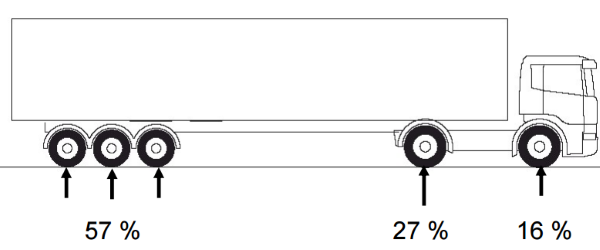
While LRR tyres can be more expensive to purchase, when used on appropriate journeys, they pay off in the long run with reduced fuel use. However, a driver must understand what type of driving will be done (and especially if it will be used in winter) so that the tyre manufacturer can supply the right tyre.
When inflated to the correct pressure they provide handling characteristics similar to regular tyres.
Trailer fairings
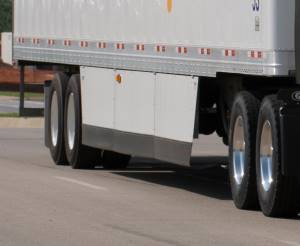 Trailer fairings are panels that stretch between the drive wheels and the trailer’s wheels. They help smooth the air flow down the side of the truck, helping prevent it swirling around the axles and chassis as it is deflected off the drive wheels. Trailer fairings have the added advantage of helping protect cyclists from being sucked under the trailer.
Trailer fairings are panels that stretch between the drive wheels and the trailer’s wheels. They help smooth the air flow down the side of the truck, helping prevent it swirling around the axles and chassis as it is deflected off the drive wheels. Trailer fairings have the added advantage of helping protect cyclists from being sucked under the trailer.
You don’t get the same advantage as a full fairing if you just have bars fitted down the side of the trailer.
Cab vanes
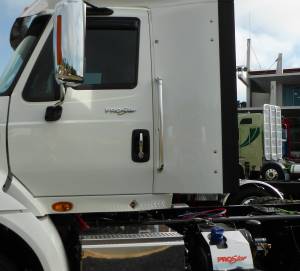 Cab vanes are fibreglass moulded curved panels that extend from the back corner of the cab and channel air around a trailer. They work in conjunction with roof deflectors (see below). They effectively reduce the distance between the cab and the trailer.
Cab vanes are fibreglass moulded curved panels that extend from the back corner of the cab and channel air around a trailer. They work in conjunction with roof deflectors (see below). They effectively reduce the distance between the cab and the trailer.
For ideal fuel economy, the trailer should be as close to the cab as possible, but this compromises the ability to manoeuvre the trailer. You can move the position of the fifth-wheel coupling, but only so far. Cab vanes effectively close the gap.
Moulded bumpers and air dams
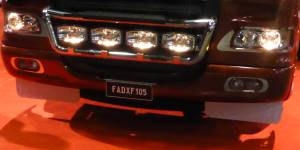 Aerodynamic bumpers and air dams help with airflow underneath the lorry, and are more curved rather than the traditional flat bumpers. Leaving a large gap between the road and the lorry doesn’t help fuel efficiency as the air gets caught up on the underside of the vehicle. It’s better to channel the air into the grille and over the body of the cab and take advantage of the aerodynamic shapes created by the cab designers, plus any other aero features you have installed.
Aerodynamic bumpers and air dams help with airflow underneath the lorry, and are more curved rather than the traditional flat bumpers. Leaving a large gap between the road and the lorry doesn’t help fuel efficiency as the air gets caught up on the underside of the vehicle. It’s better to channel the air into the grille and over the body of the cab and take advantage of the aerodynamic shapes created by the cab designers, plus any other aero features you have installed.
Cab roof fairings
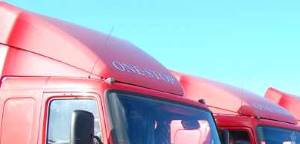 Cab roof fairings help airflow above the cab by preventing it hitting the solid wall of the front of a trailer. Some roof fairings are adjustable so that they can be lowered when the lorry is not pulling a trailer (or pulling a low trailer) to improve fuel economy. Not using a cab roof fairing can add 10% to your fuel bill.
Cab roof fairings help airflow above the cab by preventing it hitting the solid wall of the front of a trailer. Some roof fairings are adjustable so that they can be lowered when the lorry is not pulling a trailer (or pulling a low trailer) to improve fuel economy. Not using a cab roof fairing can add 10% to your fuel bill.
Roof cab fairings are also good for branding as they can be signwritten easily.
Similar vanes are being tested for trailers to form a ‘boat tail’ which tidies up the slipstream and reduces fuel consumption.
In the image below, the truck on the right has no cab roof fairing and you can easily see the large expanse of flat bodywork that is exposed to the air above the cab.
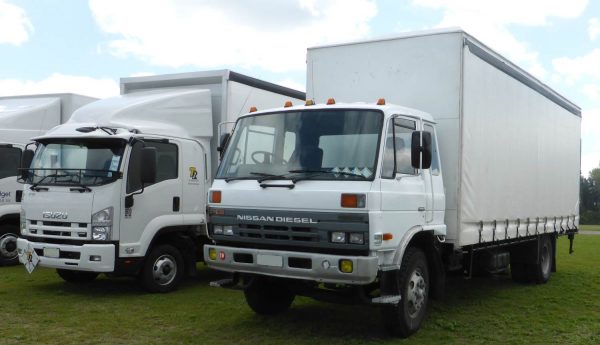
The truck on the left has superior aerodynamics with a cab roof fairing and a lower, more aerodynamic bumper
Aerodynamic lights and mirrors
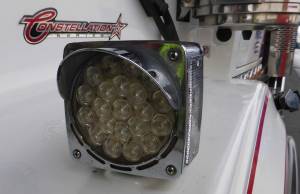 Purchasing a lorry with aerodynamic headlights and avoiding lights that are not flush with the body will help fuel economy. While additional lights improve visibility, they always compromise smooth airflow around the front of the lorry. The light pictured is not aerodynamic.
Purchasing a lorry with aerodynamic headlights and avoiding lights that are not flush with the body will help fuel economy. While additional lights improve visibility, they always compromise smooth airflow around the front of the lorry. The light pictured is not aerodynamic.
Aerodynamic mirrors have a smaller profile with more rounded contours, helping them slice through the air.
